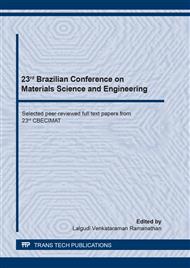p.461
p.466
p.471
p.477
p.483
p.489
p.494
p.500
p.506
Production and Characterization of the Ti-12Mo-30Nb Alloy
Abstract:
With the increasing quality of life, the growing advancement of medicine and thus greater longevity of the population, the need for the development of biomaterials becomes increasingly necessary. Titanium alloys are widely used for biomedical application because they have corrosion resistance, biocompatibility, high hardness and low elasticity modulus compared to other metallic biomaterials. In the market, the titanium alloy most used for orthopedic purposes is the Ti-6Al-4V that despite its good mechanical and structural properties, present cytotoxic elements related to the presence of Al and V, pointing out the need for the development of new materials. In the current scenario, the most outstanding alloys are β Titanium alloys, which stand out due to their low elasticity modulus, which allows a high hardness/modulus ratio. Therefore, the objective of this work was to develop new studies on the Ti-12Mo-30Nb alloy, looking for good mechanical and structural characteristics and not cytotoxicity. Therefore, this alloy was produced by arc fusion with non-consumable tungsten electrode in an argon inert atmosphere. The material was characterized by X-ray Diffraction, Scanning Electron Microscopy, Vickers Hardness and Ultrasonic Elasticity Module. According to the results, it was verified that the alloy presented only the phase β in the microstructure and a hardness/modulus ratio superior to commercial alloy.
Info:
Periodical:
Pages:
506-510
Citation:
Online since:
October 2020
Keywords:
Price:
Сopyright:
© 2020 Trans Tech Publications Ltd. All Rights Reserved
Share:
Citation:


